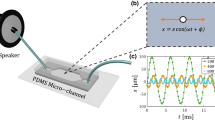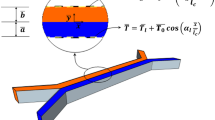Abstract
Mixing of biological species in microfluidic channels is challenging since the mixing process is limited by the small mass diffusion coefficient of the species and by the dominance of viscous effects, captured by the low value of Reynolds number characteristic of laminar liquid flow in microchannels. This paper investigates the use of pulsating flows to enhance mixing in microflows. The dependence of the degree of mixing on various dimensionless groups is investigated. These dimensionless numbers are Strouhal number, pulse amplitude divided by base velocity, Reynolds number, location along the mixing channel normalized by the channel width, channel cross section aspect ratio, and phase difference between the inlet streams. The degree of mixing, observed to experience both spatial fluctuations down the mixing channel and temporal fluctuations over a pulsation cycle at the quasi-stationary state, is shown to be most sensitive to changes in pulsation amplitude and frequency. For a fixed pulsation amplitude and Reynolds number, the degree of mixing has a peak value for a certain Strouhal number above and below which the degree of mixing decreases. Increasing the pulsation amplitude improves mixing with the behavior becoming asymptotic at large pulsation amplitudes. The temporal fluctuations in the degree of mixing over a cycle at the quasi-stationary state decrease and the average degree of mixing increases downstream the mixing channel. The fluctuations are also smaller at higher values of the Strouhal number and are generally larger for larger pulsation amplitudes. This study also takes into account the rate of work input required to overcome viscous effects. While this power input is independent of the pulsation frequency, it exhibits a parabolic dependence on the pulsation amplitude. Finally, considering the dependence of the degree of mixing (mean and standard deviation), mixing length, and energy consumption on these dimensionless groups, examples of the trade-off that has to be made in choosing the operating conditions based on different constraints are presented.































Similar content being viewed by others
Abbreviations
- A :
-
Channel cross-sectional area
- c :
-
Concentration of a species
- \(\overline{c}\) :
-
Reference concentration
- D :
-
Mass diffusivity
- E :
-
Total energy
- f :
-
Pulsation frequency
- h :
-
Enthalpy
- H :
-
Channel height (or depth)
- L :
-
Channel length
- \(\dot{m}\) :
-
Mass flow rate
- p :
-
Pressure
- Q :
-
Volume flow rate
- \(\overline{Q}\) :
-
Base volume flow rate
- R :
-
Channel resistance
- t :
-
Time
- T :
-
Pulsation period
- U :
-
Characteristic speed
- V :
-
Average velocity
- \(\overline{V}\) :
-
Base/mean velocity
- \(\mathbf {v}\) :
-
Velocity vector \((v_x,v_y,v_z)\)
- W :
-
Channel width
- \(W_{v, {\hbox {cycle}}}\) :
-
Work input to overcome friction during a cycle
- x :
-
Coordinate along the mixing channel
- y :
-
Coordinate along channel width
- z :
-
Coordinate along channel height
- Re :
-
Reynolds number
- Pe :
-
Peclet number
- St :
-
Strouhal number
- Sc :
-
Schmidt number
- \(\alpha\) :
-
Angle between the two inlet channels
- \(\beta\) :
-
Channel resistance correction factor
- \(\delta V\) :
-
Amplitude of pulsed velocity
- \(\delta Q\) :
-
Pulsation volume flow rate
- \(\gamma\) :
-
Channel cross section aspect ratio
- \(\kappa\) :
-
Kinetic energy correction factor
- \(\overline{\mu }\) :
-
Average degree of mixing
- \(\eta\) :
-
Dynamic viscosity
- \(\nu\) :
-
Kinematic viscosity
- \(\omega\) :
-
Angular velocity
- \(\phi\) :
-
Phase difference
- \(\rho\) :
-
Density
- \(\sigma _\mu\) :
-
standard deviation in degree of mixing
- \(\theta\) :
-
Ratio of channel width to length
- \(\xi\) :
-
Mass fraction of a species
- \(\xi _{\hbox {max}}\) :
-
Mass fraction at perfect mixing
- \(^*\) :
-
For dimensionless variables
- 1:
-
For inlet channel 1
- 2:
-
For inlet channel 2
- 3:
-
For mixing channel
References
Atkins P, De Paula J (2010) Physical chemistry for the life sciences. Oxford University Press, Oxford
Bessoth F (1999) Microstructure for efficient continuous flow mixing. Anal Commun 36(6):213–215
Capretto L, Cheng W, Hill M, Zhang X (2011) Micromixing within microfluidic devices. In: Microfluidics. Springer, pp 27–68
Chang CC, Yang RJ (2007) Electrokinetic mixing in microfluidic systems. Microfluid Nanofluid 3(5):501–525
Du E, Manoochehri S (2010) Optimal design of microgrooved channels with electrokinetic pumping for lab-on-achip applications. Nanobiotechnol IET 4(2):40–49
Glasgow I, Aubry N (2003) Enhancement of microfluidic mixing using time pulsing. Lab Chip 3(2):114–120
Glasgow I, Lieber S, Aubry N (2004) Parameters influencing pulsed flow mixing in microchannels. Anal Chem 76(16):4825–4832
Goullet A, Glasgow I, Aubry N (2005) Dynamics of microfluidic mixing using time pulsing. Discrete Contin Dyn Syst Suppl 2005:327–336
Goullet A, Glasgow I, Aubry N (2006) Effects of microchannel geometry on pulsed flow mixing. Mech Res Commun 33(5):739–746
Hessel V, Löwe H, Schönfeld F (2005) Micromixers—a review on passive and active mixing principles. Chem Eng Sci 60(8):2479–2501
Issa L (2015) Perturbation-based simplified models for unsteady incompressible microchannel flows. Appl Math Model. doi:10.1016/j.apm.2015.12.025. http://www.sciencedirect.com/science/article/pii/S0307904X15008379
Karniadakis G, Beskok A, Aluru N (2006) Microflows and nanoflows: fundamentals and simulation, vol 29. Springer, Berlin
Knight JB, Vishwanath A, Brody JP, Austin RH (1998) Hydrodynamic focusing on a silicon chip: mixing nanoliters in microseconds. Phys Rev Lett 80(17):3863
Lakkis IA (2008) System-level modeling of microflows in circular and rectangular channels. In: ASME 2008 6th international conference on nanochannels, microchannels, and minichannels. American Society of Mechanical Engineers, pp 1159–1170
Lim Y, Kouzani A, Duan W (2010) Lab-on-a-chip: a component view. Microsyst Technol 16(12):1995–2015
Lu LH, Ryu KS, Liu C (2002) A magnetic microstirrer and array for microfluidic mixing. J Microelectromech Syst 11(5):462–469
Patrascu M, Gonzalo-Ruiz J, Goedbloed M, Brongersma SH, Crego-Calama M (2012) Flexible, electrostatic microfluidic actuators based on thin film fabrication. Sens Actuators A: Phys 186:249–256
Stone HA, Stroock AD, Ajdari A (2004) Engineering flows in small devices: microfluidics toward a lab-on-a-chip. Annu Rev Fluid Mech 36:381–411
Author information
Authors and Affiliations
Corresponding author
Rights and permissions
About this article
Cite this article
Cheaib, F., Kekejian, G., Antoun, S. et al. Microfluidic mixing using pulsating flows. Microfluid Nanofluid 20, 70 (2016). https://doi.org/10.1007/s10404-016-1731-4
Received:
Accepted:
Published:
DOI: https://doi.org/10.1007/s10404-016-1731-4




